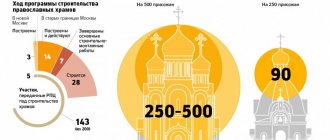Programs for users
Here is a toolkit for working with Church Slavonic texts in Windows. As already noted, the Western version of Windows is designed to write no more complex than the diacritics of European languages, and does not have sufficient capabilities to display the Church Slavonic language. Therefore, additional tools are needed to expand the capabilities of the system. On the other hand, many truly convenient software products have been created for Windows. Microsoft Word for typing, PageMaker or QuarkXPress for layout, Finale as a music editor... If the architecture of a branded product is sufficiently open for additions, it is more logical to create Church Slavonic tools as additions to finished products rather than writing your own full-featured product from scratch. Therefore, my main package - “Irmologii-4” - was written mainly as a series of additions to well-known products.
Irmology-4
Version 4.20 from 05/02/2010
History of changes and what's new
A package for working with Church Slavonic texts. This is my main product.
The package is installed on Microsoft Word for Windows versions from 2000 to 2010 (32-bit only) and works there as an Add-on. An additional tab appears on the ribbon (Word 2007+) or an additional menu item (Word 2000-2003), the ability to enable the Church Slavonic layout and much more. Here is a list of its capabilities.
By enabling the Church Slavonic layout, you can quite comfortably type Church Slavonic texts in UCS8 encoding without switching registers, without worrying about the complex arrangement of fonts, multiple composites, or different types of superscripts for different cases. You simply press the “direct stress” key, and the program itself determines the most optimal and beautiful way to depict this stress over the letter;
You can edit already typed text. We press the “direct stress” key next to the composite letter, which is accompanied by mistake by several superscripts - the program restores the original letter, clears it of “garbage” and places the desired superscript in the most optimal combination;
the program tracks and fills in some obvious cases of CA spelling; for example, aspirations are entered automatically when typing;
There is a layout editor. We tried to make the layout as optimal as possible for speed dialing; but, if you don’t like the Church Slavonic layout that comes with the program by default, you can completely redo it. The layout editor is convenient and intuitive;
there are a number of converters: from HIP, to HIP, from the old Irmologion, with and without preserving formatting, with many settings (which, however, you can not study or touch if you wish);
there are a number of service functions for text formatting - for example, advanced work with drop caps;
The package comes with an installer.
The program can only be installed on Word versions 2000 and higher (tested up to and including version 2010; the 64-bit version is not supported). If you have a weak computer and only Word 97 is available to you, use the older, third version of Irmology.
Attention!
Be sure
to download one or more CA fonts along with the program We no longer embed fonts in the Irmology installer due to their wide variety. Fonts can be found on the same website, here.
Irmology-3
Version 3.12.05 from 04/06/2003
History of changes and what's new
This is an older version of the current Irmology-4. It may be required only if you have a weak computer with Word 97, and you cannot install Word version at least 2000 on it. In other words, the version is left here “for compatibility.”
The capabilities of Irmology-3 are more modest, but it allows you to confidently type and edit text. All necessary converters are also present.
Our ability to support this version is extremely limited.
HIP to RTF converter
Version 4.03 from 07/05/2006
History of changes and what's new
A utility that converts HIP files into RTF format. If you do not need to type Church Slavonic texts from the keyboard, but there is a need to use ready-made texts in HIP format (say, from the site orthlib.ru), this utility is your choice.
The utility is a regular Windows application that does not require the installation of any additional programs (in particular, it does not depend on MS Word). The operating system, however, must be at least Windows 98.
You can specify files for conversion by name or simply drag and drop them from Explorer.
In one step, you can process a group of files located in a specified folder at once (simply by dragging the desired folder into the converter window), and the folder may contain subdirectories.
It is possible to change the appearance of the created text by managing numerous program settings.
For command line lovers, there is also a console version of the converter that works through command line parameters. There is evidence that the console utility even works on Linux using an emulator.
The utility is supplied with an installer.
In addition to the converter distribution, do not forget to download and install at least one Church Slavonic font in Ucs8 encoding (take it from here).
Developer Toolkit
As I work on fonts, I, like any other developer, accumulate a small collection of various utilities, test cases and other little things made by myself. This is exactly the little thing that cannot be found in standard programs, but which greatly helps in the work. In other words, personal developer tools. Some of these tools may well be useful to other font creators, so I decided to post them in a separate section. The average user will most likely not be interested here.
A utility for solving problems with superscripts in Microsoft Internet Explorer
As you know, using fonts with zero-width characters (usually superscripts) in IE since version 5.0 has been a problem. Starting at some point (IE 5.0 - less often, IE 6.0 - almost always), the browser begins to insert something like a space after each zero-width character. It doesn't look very nice: . One way to fix this problem is to modify the font used. The fact is that the amount of inserted “space” is equal to the “average character width” parameter (xAvgCharWidth in the 'OS/2' table of the ttf file). Therefore, if you set this value small enough, "spaces" will continue to be inserted, but their apparent width will be zero or very small. Unfortunately, this solution cannot be called ideal. For example, in Word XP, with installed support for Chinese letters with fonts modified in a similar way, the justification does not work correctly: the minimum space value in this particular software configuration is for some reason set equal to the average character width, but not the width of the white space character specified by the designer. As a result, for example, all fonts from the “Fonts” section originally adjusted for IE have been returned to their original state, and a separate version of UCS fonts with the suffix ieUcs has been released specifically for use in IE. But at least this is one of the working solutions
Problems.
Existing font editors, as a rule, do not allow you to edit the “average character width” parameter directly. Instead, it is calculated by the editor each time the font is compiled. Suggested utility SetACW.exe
modifies this parameter in an already compiled ttf font. The utility is controlled from the command line. At startup, the font name and parameter value are specified. Instructions included.
A set of difficult words for testing fonts
Useful for font developers to test the position of superscripts. Just a bunch of words with all possible accents on all possible letters, plus a selection of potentially problematic words with letter-titles. See how these words will look in your font. But don’t rush to throw it in the trash in despair if a couple of difficult words look terrible and nothing can be done - that’s the typeface. I've collected all the possible
problematic cases, but you need to assess the real probability of encountering a particular word in the text.
IRMOLOGY
Greek Irmologius. X–XI centuries (Ath. Lavr. B. 32. Fol. 2v – 3)
Greek Irmologius. X–XI centuries (Ath. Lavr. B. 32. Fol. 2v – 3) Byzantine. I.'s lists represent the next stage of development of this collection after the one reflected in the ancient cargo. lists. The only exception is the fragment I. - so-called. Princeton palimpsest Garrett 24, the upper layer of which is Georgian (986), and the lower layer is Greek (late 8th century) (see: Raasted. 1992; Jeffery. 2003). If Georgian Irmos represents the stage of expanding and collecting the repertoire into a single collection, then Greek Irmos represents the stage of selecting and reducing the total number of irmos, their systematization and generalization.
Relatively complete lists of Greek I. have been preserved since the 10th century. Total from X-XV centuries. A little more than 40 Greek I. are known. So small compared to other types of chanters. books of the Palestinian tradition, the number of lists can be explained both by the auxiliary, non-liturgical purpose of I., and by its more frequent use compared to other singers. books using (Velimirović. 2001).
The most ancient complete Greek I. Ath. Laur. Β. 32 (X century) is at the same time the largest in composition: it contains approx. 340 canons (if you count those canons that were located on the lost first sheets) and approx. 3 thousand irmos. I. Hieros. Sab. 83 (c. 1100; ed.: Hirmologium Sabbaiticum. 1968-1970) already contains irmos of less than 300 canons. By the 14th century I.'s repertoire decreased by more than 2/3. New irmos practically do not appear after 1100 (see: Harris. 2004. P. 181).
There are 5 known Greek lists of I. X-XI centuries. with the following canons: Ath. Laur. B. 32; Patm. 55 (X-XI centuries); Hieros. Sab. 83; RNB. Greek No. 557 (XI century; fragment); Ath. Esph. 54 (XI century). The section of each voice consists on average of 40 sequences of irmos (canons). The sequence of canons in different lists is different, each list contains approx. 300-350 canons, approx. 2.5-3.2 thousand irmos.
In the XII-XIII centuries. the sequence of canons in I. of this type was unified (although some differences remained in the choice of irmos). This stage is characterized by a decrease in the number of canons in each voice to 20-25, the number of canons in each list - to 160-200, the total number of irmos - to 1.2-1.8 thousand. This stage includes the following lists (certain exceed the specified time frame): Crypt. E. γ. III (beginning of the 12th century); Patm. 54 (XII century); Paris. Coislin. gr. 220 (XI-XII centuries); Ath. Ivir. 470 (1177; ed.: Hirmologium Athoum. 1938); Crypt. E. γ. II (1281; ed.: Hirmologium Сryptense. 1951); Ath. Vatop. 1531 (XIV century).
For lists of the XIV-XV centuries. with the succession of canons, a further reduction in volume to 12-15 canons in each voice, 100-120 canons and 800-1000 irmos in the list is characteristic, while some of the irmos, excluded from I. XII-XIII centuries, began to be used again. Lists of this type: Ath. Laur. Γ. 9 (early 12th century); RNB. Greek No. 121 (1302); Sinait. gr. 1256 (1309); 1257 (1332); Ath. Ivir. 1044 (1st half of the 14th century); Athen. Bibl. Nat. 2057 (1st half of the 14th century); Ath. Vatop. 1532; Ath. Pantokr. 215; Patm. 480; Sinait. gr. 1275, 1276 (all 5 lists - XIV century); Cantabr. S. Trin. 1165 (XIV century; see ed.: Twenty Canons. 1952); Ath. Ivir. 1259 (late 14th century); Sinait. gr. 1262 (1437).
Greek Irmologius. X–XI centuries (Patm. 55. Fol. 156–157v)
Greek Irmologius. X–XI centuries (Patm. 55. Fol. 156–157v)
Much less Greek I. with the succession of songs has been preserved than with the succession of the canons. This is the Princeton palimpsest and lists: Sinait. gr. 929 (2nd half of the 11th century); Paris. Suppl. gr. 1284 (1st half of the 12th century, fragment - 2 sheets); Sinait. gr. 1258 (1257); Ath. Laur. Δ. 35 (XIII century); Hieros. Patr. Sab. 599, 617 (both late XIII - early XIV centuries); Ath. Philoth. 132 (XIV century), 131 (1st half of the 15th century), 123 (end of the 14th century; section of the collection: irmos of the canons of the Great Pentecost, Holy Week, Penticostaria and some saints). Initially, I. followed by songs contained a small number of irmos, in the beginning. XIV century its composition was expanded. I. with the succession of the songs also includes those irmos that were excluded from I. with the succession of the canons in the 12th-13th centuries. and returned to lists of this type in the 14th century. (Velimirović. 2001).
There are I. of mixed type, combining both types of arrangement of irmos within the vowel sections (see lists: Wash. Libr. of Congress. Music Division. 2156, XII century; Vat. Palat. gr. 243, XIV century; Patm. 473 , XIV century; Ath. Karakal. 224, late XIV century; Sinait. gr. 1588, XIV-XV centuries).
Already in the initial period of the history of the canon, hymnographers began to often use the irmos of previous authors in their works. Following After selecting the most popular irmos, composite canons appeared, for which irmos were selected from different sequences of irmos (for example, in the list Wash. Libr. of Congress. Music Division. 2156).
M. Velimirović and some other researchers have suggested that the lists of Greek. I. with the following of canons are associated with the Polish and Athos traditions, and lists with the following of songs are associated with the Palestinian and Sinai (see: Velimirović M. Byzantine Elements in Early Slavic Chant: The Hirmologion. Copenhagen, 1960. P. 46. ( MMB. Subs.; 4); Onasch. Lexicon. P. 162). This hypothesis is consistent, in particular, with the assumption that the oldest Greek I. followed by songs - the Princeton palimpsest - although it was used in Sinai, is of Jerusalem or Palestinian origin (see: Raasted. 1992; Jeffery. 2001. P. 196) . Metreveli proposed to differentiate in time the data on the spread of different types of Greek I. She believes that I, with the succession of the canons, was adapted for creating new hymns and for training singers, therefore it was distributed primarily in the largest hymnographic centers (in the monastery of St. Sava in Palestine , in K-field, on Mount Athos, in Southern Italy) during the periods of greatest creative activity of these centers, and I., followed by song, was used primarily in liturgical practice (see: Metreveli. 1971. P. 119).
Greek Irmologius. Beginning XII century (Crypt. E. g. III. Fol. 185)
Greek Irmologius. Beginning XII century (Crypt. E. g. III. Fol. 185)
O. Strunk in the edition of I. Hieros. Sab. 83 notes that each voice begins with the same sequence of canons: John of Damascus, Cosmas of Mayum, Andrew of Crete and Herman of K-Pol (the exception is the 3rd voice, where the canon of Mon. Stephen is inserted between the canons of Andrew and Herman). 140 canons are written in this order, i.e. approx. 1/2 of the total number of canons on this list. It is these canons that make up the main and most stable core of I. They are recorded both in the most ancient and in later I. with minor variations (see: Busch. 1971. S. 42-86; here is a table of Irmos of the 2nd tone based on 26 manuscripts of the X-XIV centuries). Those irmos from the Princeton palimpsest that were identified are associated in later sources with the names of John and Cosmas (Jeffery. 2001. P. 196). In addition to the above-mentioned authors, Andrei Pir, Patriarch Elijah, mon. are repeatedly mentioned in I. Cyprian, St. Theodore the Studite, mon. Damian, George the East (᾿Ανατολικός), Sergius I, Patriarch of K-Polish, etc. For a number of canons, instructions are contained that can indicate both the nickname of the hymnographer and the place of origin of the canon: Σιναΐτης (Sinaitic), Βυζάντιος (Byzantine), Σ ικελιώτης (Sicilian).
Sometimes the same irmos are attributed to different authors, even within the same manuscript, which is associated with the tradition of writing new canons on already known irmos: when repeated, not the author of the original irmos may be indicated, but the author of the newly written canon. Borrowing irmos for a new canon from different canons further complicates their attribution to one or another author.
The absolute majority of Greek I. are notated, which is due to their purpose. Even in the ancient Princeton palimpsest there are separate signs of the so-called. fit notation (see art. Byzantine notation), and they are located in places where in later I. there are chant signs (θεματισμός; see: Raasted. 1992. P. 223-224). Among the unnotated I. one can name Hieros. Sab. 46 and 682, con. XIV century, both belong to the type with song sequences.
All types of Byzantines are represented in I.'s lists. notations: extremely archaic fitnaya in the Princeton palimpsest, Chartres in Ath. Laur. Β. 32, in a number of manuscripts Kualensky - from archaic to developed (Patm. 55; Ath. Esph. 54; Hieros. Sab. 83; Paris. Coislin. 220, etc.), in a significant number I. - Middle Byzantine (Wash. Libr . of Congress. Music Division. 2156; Cantabr. S. Trin. 1165; Sinait. gr. 1256, 1257; Ath. Vatop. 1532, etc.).
Greek Irmologius. XI–XII centuries (Paris. Coislin. 220. Fol. 156)
Greek Irmologius. XI–XII centuries (Paris. Coislin. 220. Fol. 156)
A unique feature of I. is the exceptional stability of texts and tunes. Velimirović wrote about the preservation of the Byzantines. I.'s tunes from their creation to decipherable monuments of the 12th century. and o the existence of a stable melodic tradition. The melodies of the Irmos are predominantly syllabic in nature with a small amount of melismatics, which is explained by the use of each melody for plurals. texts. This also explains the presence of a large number of melodic formulas, which made it much easier for singers to learn melodies by heart (see: Velimirović. 2001).
There are 2 main melodic versions of Byzantine I., first identified in scientific literature by G. Tilyard. The first is recorded in ancient lists and is more stable; all I. from the early Byzantine era belong to it. notation and a number of manuscripts from the Middle Byzantine era. notation (at the same time, the “abbreviated” version of the Byzantine stichirarion and the oldest version of Slavic I. are close to it). The earliest list where the 2nd version is recorded is Sinait. gr. 1258; its more developed stage is represented in the Hieros lists. Sab. 599, 617; Vat. Palat. gr. 243; Sinait. gr. 1256 and others. From the turn of the XIII and XIV centuries. and until about 1500 the 2nd version was predominant (Strunk. 1963. P. 372). She is often associated with the name of St. John Kukuzel, since in two I. of this tradition (RNB. Greek No. 121, 1302, and Sinait. gr. 1256, 1309) there are records that these books were compiled by Kukuzel (for example, RNL. Greek No. 121. Sheet 148 volume: ιε´ (The End with God And rhmology, the creation of John Papadopoulos, verb Kukuzel: years 6810 [=1302 AD] in(diction) 15)). Scientists have explained in different ways the appearance of a new version of the Byzantine I.K. Hoeg considered the 2nd, “simplified” version to be associated with Mon-Rem St. Savva the Sanctified (Høeg C. Introduction // The Hymns of the Hirmologium. 1952. P. XXXV-XXXVI). Strunk, also emphasizing the related nature of the 2 versions, put forward the assumption that the 2nd version was the result of the evolution of the 1st in the oral tradition, while the non-normative recording of the 1st version remained unchanged; when the differences between them reached a critical level, the 2nd version was recorded. As evidence, he cited the fact that the 2nd version has many more melodic variations in different manuscripts. At the same time, he denied the connection of the 2nd version of I. with the early Palestinian tradition, based on the similarity of the first with the version of the lists of the Sunday Stichirarion, which are not related to Palestine (Strunk. 1963. P. 372-373).
Greek lists of the 16th-19th centuries, as a rule, are either I. with the succession of canons (for example, Ath. Ivir. 1101, late 15th - early 16th centuries; there are also single copies of a mixed type - for example, Ath. Philoth 125, XV-XVI centuries), or collections of catastrophes (for example, Ath. Ivir. 1185, XVI century), or collections of 2 sections of the specified content (Ath. Ivir. 1259, late XV century; Ath. Doch. 408, late XVI - early XVII centuries).
Irmology of Peter the Peloponnesian. Con. XVIII – beginning XIX century (Ath. Vatop. 1398. Fol. 1)
Irmology of Peter the Peloponnesian. Con. XVIII – beginning XIX century (Ath. Vatop. 1398. Fol. 1)
From the end XVI century I.'s own melodic versions began to appear, for example. hierome (after Patriarch of K-Polish) Theophanes Karikis († 1597) (lists: Ath. Laur. E. 200, ca. 1600; Ath. Xenoph. 159, 1607-1610; Ath. Ivir. 1154, XVII century; 1155, 1167, both - 1st half of the 17th century; Hieros. Patr. 561, 17th century), mon. Vatopedi monastery of Joasaph the New Kukuzel (2nd half of the 16th - early 17th century) (lists: Ath. Laur. K. 158, early 17th century; Ath. Ivir. 1192, early 17th century; 1248, 1st half of the 17th century; Vat. Barb. gr. 301, 17th century), domestic of the Iveron Monastery on Athos Cosmas the Macedonian (last third of the 17th century) (lists: autograph of Ath. Ivir. 1074 , 1682; Zakinfos. P. Gritsanis. 8, 1698; Ath. Ivir. 1048, 1686), priest. and nophylax Great c. Balasis (last third of the 17th century) (lists: Ath. Ivir. 1686; Sinait. gr. 1494, 1679; Ath. Ivir. 1021, 1701, and other manuscripts of the 17th-18th centuries) .
The author's melodic versions of I. katavasiya belong to the protopsalt of the Great Church. Panagiotis Chrysaphos the New (2nd half of the 17th century) (lists: Lesb. Leim. 239, 1672-1673), Herman, Metropolitan. New Patras (2nd half of the 17th century) (lists: Ath. Ivir. 1048, 1686; Lesb. Leim. 243. Fol. 73-103v, 1787; Ath. Prodromou. 1, 18th century; Ath. Doch. 407, XVIII century; Ath. Laur. Ε. 113, Θ. 153; Ath. Vatop. 1379, XVII century; Ath. Xeropot. 325, XVIII century; 380, 1759), domestic (after the lampadarium) Great Ts. Peter of the Peloponnese († 1778) (his I. with a lengthy irmological melos is an abbreviated and simplified version of the melodic version of Balasis; lists: Zakinfos. P. Gritsanis. 13, 1773; Lesb. Leim. 246, 1779-1793; Ath Xeropot 375, 1783; 372, 1785; 386, late 18th century). According to the manuscript Ath. Xeropot. 262 (1st half of the 17th century) the anonymous I. Katavasy is known, whose melos is similar to the version of I. Herman, Metropolitan. New Patr.
Later, I. short, syllabic melos spread: protopsalta Great c. Peter of Byzantium († 1808) (I. followed by songs; lists: Ath. Pantel. 999, 1803; Ath. Vatop. 1378, 19th century; Sinait. gr. 2086, 1805; Athen. Bibl. Nat. 964, 1806; Athen. Bibl. Nat. S. Sepulcri. 740, 1805 (autograph)) and Domestic Mark (1st half of the 19th century) (Ath. Gregor. 16 , 1832).
Melodic versions of individual sequences of irmos in Greek I. XVIII-XIX centuries. belong to the priest. Anthimus the Thessalian (late 17th century) (Ath. Ivir. 1243, 18th century), Peter Bereket (early 18th century) (Athen. K. Psachou. 79, late 18th century; Ath. Pantel. 975 , mid-18th century), protopsalt of the Great Church. Constantine of Byzantium (student of George of Crete and protopsalt Manuel; his I. was partially published as part of the 1st volume of his Doxastarios (K-pol, 1841)) (see: ῾Αντωνίου. 2004).
Publisher: Εἱρμολόγιον τῶν καταβασιῶν Πέτρου τοῦ Πελοποννησίου μετὰ τοῦ Σ ? ἤδη κα ἀκριβῶς διορθωθέντα παρὰ τοῦ διδασκάλου Χουρμουζίου Χαρτο φύλακος. Κωνσταντινούπολις, 1825; ? ?? ᾿Εκκλησίας / ᾿Εκδ. παρὰ Θ. Π. Παράσχου Θωκέως. Κωνσταντινούπολις, 1835; ? ννου Προτοψάλτου. Κωνσταντινούπολις, 1903; Σωφρόνιος (Εὐστρατιάδης), μητρ. Εἱρμολόγιον. Chennevières-sur-Marne, 1932, 1955r. (῾Αγιορειτικὴ βιβλιοθήκη; 9); Hirmologium Athoum: Cod. Monasterii Hiberorum 470/Ed. C. Høeg. Copenhagen, 1938. (MMB. Ser. princip.; 2); Hirmologium Сryptense / Ed. L. Tardo. R., 1951. (MMB. Ser. princip.; 3); The Hymns of the Hermologium. Copenhagen, 1952. Pt. 1/Ed. A. Ayoutanti, M. Stöhr, C. Høeg. (MMB. Transcr.; 6); 1956. Pt. 3.2/Ed. A. Ayoutanti, H. J. W. Tillyard. (MMB. Transcr.; 8); Twenty Canons from the Trinity Hermologium / Ed. H. J. W. Tillyard. Boston; Copenhagen etc., 1952. (MMB. Transcr.; 4); Hirmologium Sabbaiticum/Ed. J. Raasted. Copenhagen, 1968-1970. 3 parts. (MMB. Ser. princip.; 8); Metreveli E. Two ancient editions of cargo. Irmology: (According to manuscripts of the 10th-11th centuries). Tbilisi, 1971 (in Georgian); Hymns of Michael Modrekili: X century. / Ed.: V. A. Gvakharia, R. Gurchuladze, Sh. Amiranashvili. Tbilisi, 1978. 3 volumes (in Georgian); Unarmed Irmologii: (Rkp. A-603) / Prepared. text, research and decree: G.I. Kiknadze. Tbilisi, 1982 (in Georgian).
Lit.: Garitte G. Le calendrier palestino-géorgien du Sinaïticus 34 (Xe siècle). Brux., 1958; Strunk O. Melody Construction in Byzantine Chant // Actes du XIIe Congrès Intern. d'Études Byzantines, Ochride, 1961. Beograd, 1963. Vol. 1. P. 363-384 (republished in: Idem. Essays on Music in the Byzantine World. NY, 1977. P. 191-201); Ingorokva P.I. Collection. op. Tbilisi, 1965. T. 3. P. 79-92 (in Georgian); Stöhr M. Reflections on Transcribing the Hirmoi in Byzantine Music // SEC. 1966. Vol. 1. P. 89-94; Schirò G. Problemi heirmologici // The Proceedings of the XIII Intern. Congr. of Byzantine Studies/Ed. by JM Hussey et al. L. etc., 1967. P. 255-266; Busch R., von. Untersuschungen zum byzantinischen Heirmologion der Echos Deuteros. Hamburg, 1971; Velimirović M. The Byzantine Heirmos and Heirmologion // Gattungen der Musik in Einzeldarstellungen: Gedenkschrift L. Schrade / Hrsg. W. Arlt et al. Bern; Münch., 1973. S. 192-244; idem. Heirmologion // NGDMM. 2001. Vol. 11. P. 332-359; idem. Heirmologion // Grove Music Online // https://www.oxfordmusiconline.com/public/book/omo_gmo [Electr. resource]; Métrévéli E., Outier B. Contribution à l'histoire de l'Hirmologion: anciens hirmologia géorgiens // Le Muséon. Louvain, 1975. T. 88. P. 331-359; Follieri E. “The Living Heirmologion” in the Hymnographic Production of John Mauropus, Metropolitan of Euchaita // SEC. 1979. Vol. 4. P. 54-75; Raasted J. Byzantine Heirmoi and Gregorian Antiphons: Some Observations on Structure and Style // Musica antiqua. Bydgoszcz, 1988. T. 8. P. 837-862 (Idem // CIMAGL. 1989. T. 59. P. 271-296); idem. The Princeton Heirmologion Palimpsest // CIMAGL. 1992. T. 62. P. 219-232; Jeffery P. The Earliest Christian Chant Repertory Recovered: The Georgian Witnesses to Jerusalem Chant // JAMS. 1994. Vol. 47. P. 3-38; idem. The Earliest Oktoechoi: The Role of Jerusalem and Palestine in the Beginnings of Modal Ordering // The Study of Medieval Chant: Paths and Bridges, East and West: In Honor of K. Levy / Ed. by P. Jeffery. Woodbridge (Suffolk, UK); Rochester (NY), 2001. P. 194-200; idem. A Window on the Formation of the Medieval Chant Repertories: the Greek Palimpsest Fragments in Princeton Univ. Ms Garett 24 // The Past in the Present: Papers Read at the Intern. Musicological Society Intercongressional Symp. and the 10th Meeting of the “Cantus Planus”, Budapest & Visegrád, 2000. Bdpst, 2003. P. 1-21; Lozovaya I. E. On the system of singing the weekly canons of the Octoechos in the early liturgical tradition // Gymnology. M., 2003. Issue. 4: Byzantium and East. Europe: Liturgist. and music communications: (To the 80th anniversary of M. Velimirović). pp. 52-68; Harris S. The “Kanon” and the Heirmologion // Music and Letters. 2004. Vol. 85. N 2. P. 175-197; ᾿Αντωνίου Σ. Τὸ Εἱρμολόγιον κα ἡ παράδοση τοῦ μέλους του / ᾿Εκδ. Γ. Θ. Στάθης. ᾿Αθῆναι, 2004; Nikiforova A. Yu. The problem of the origin of the official Menaion: Structure, composition, Greek month book. Menaeus IX-XII centuries. from the monastery of St. Catherine on Sinai: AKD. M., 2005; Krivko R. N. Sinai-Slavic hymnographic parallels // Vestn. PSTGU. 2008. Ser. 3: Philology. Vol. 1(11). pp. 56-102.
Yu. R. Shlikhtina, E. P. M.








